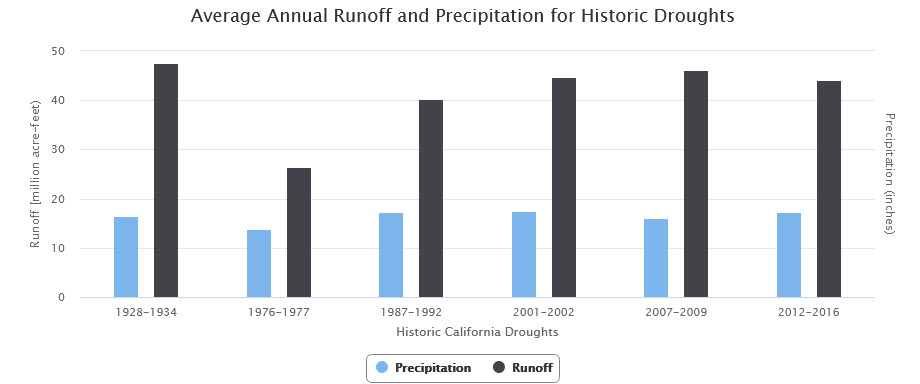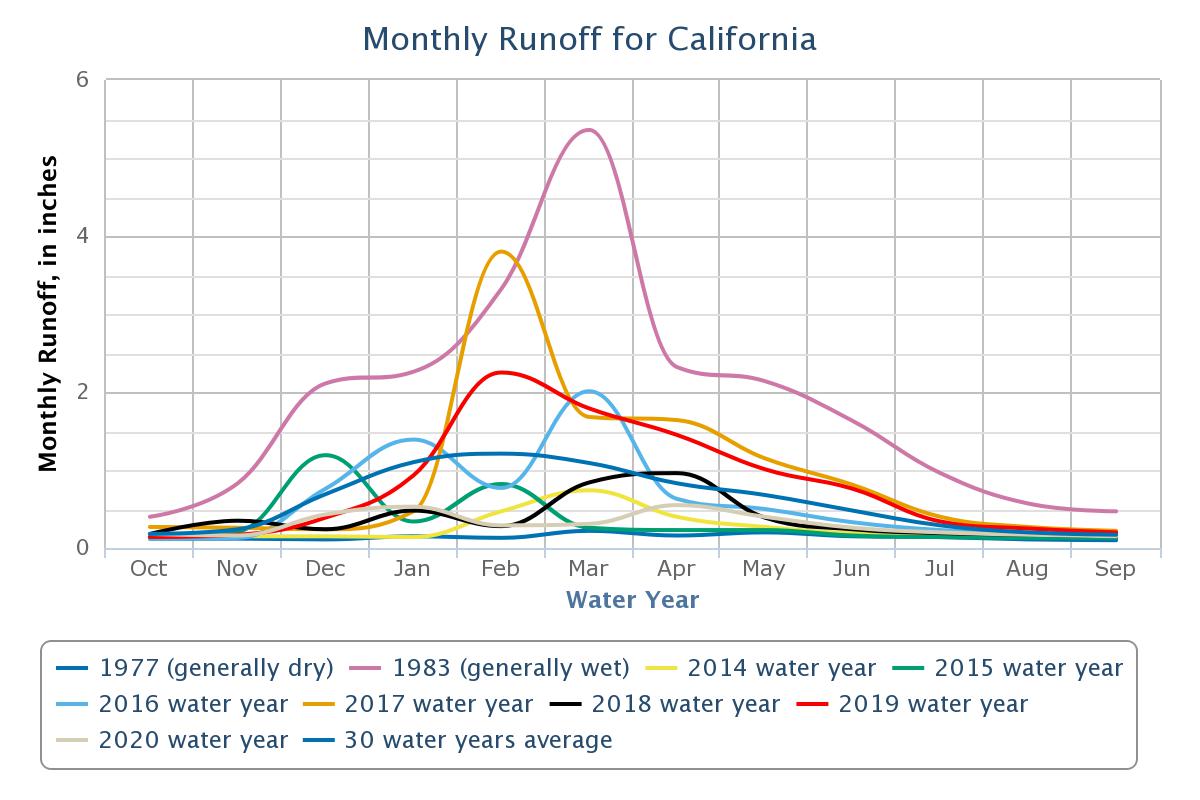Lake Oroville and the Enterprise Bridge looking from the South Fork in 2015
Photo by DWR
What is a drought?
While it is relatively easy to define what a hurricane or earthquake is, defining a drought is more subjective. Droughts do not have the immediate effects of floods, but sustained droughts can cause economic stress throughout an area. The word "drought" has various meanings, depending on a person's perspective. To a farmer, a drought is a period of moisture deficiency that affects the crops under cultivation—even two weeks without rainfall can stress many crops during certain periods of the growing cycle. To a meteorologist, a drought is a prolonged period when precipitation is less than normal. To a water manager, a drought is a deficiency in water supply that affects water availability and water quality. To a hydrologist, a drought is an extended period of decreased precipitation and streamflow.
What causes droughts?
A drought is a period of drier-than-normal conditions that results in water-related problems. Precipitation (rain or snow) falls in uneven patterns across the country. The amount of precipitation at a particular location varies from year to year, but over a period of years, the average amount is fairly constant. In the deserts of the Southwest, the average precipitation is less than 3 inches per year. In contrast, the average yearly precipitation in Atlanta is about 50 inches.
The amount of rain and snow also varies with the seasons. In Georgia, most of the yearly precipitation falls during winter, early spring, and in July. Even if the total amount of rainfall for a year is about average, rainfall shortages can occur during a period when moisture is critically needed for plant growth, such as in the early summer.
When little or no rain falls, soils can dry out and plants can die. When rainfall is less than normal for several weeks, months, or years, the flow of streams and rivers declines, water levels in lakes and reservoirs fall, and the depth to water in wells increases. If dry weather persists and water-supply problems develop, the dry period can become a drought (Moreland, 1993).
When does a drought begin?
The beginning of a drought is difficult to determine. Several weeks, months, or even years may pass before people know that a drought is occurring. The end of a drought can occur as gradually as it began. Dry periods can last for 10 years or more. During the 1930's, most of the United States was much drier than normal. In California, the drought extended from 1928 to 1937. In Missouri, the drought lasted from 1930 to 1941. That extended dry period produced the "Dust Bowl" of the 1930's when dust storms destroyed crops and farms.
The first evidence of drought usually is seen in records of rainfall. Within a short period of time, the amount of moisture in soils can begin to decrease. The effects of a drought on flow in streams and reservoirs may not be noticed for several weeks or months. Water levels in wells may not reflect a shortage of rainfall for a year or more after a drought begins (Moreland, 1993).
Does a shortage of rain mean that a drought will occur?
A period of below-normal rainfall does not necessarily result in drought conditions. Some rain returns to the air as water vapor when water evaporates from water surfaces and from moist soil. Plant roots draw some of the moisture from the soil and return it to the air through a process called transpiration. The total amount of water returned to the air by these processes is called evapotranspiration. Sunlight, humidity, temperature, and wind affect the rate of evapotranspiration. When evapotranspiration rates are large, soils can lose moisture and dry conditions can develop. During cool, cloudy weather, evapotranspiration rates may be small enough to offset periods of below-normal precipitation and a drought may be less severe or may not develop at all (Moreland, 1993).
Why doesn't a drought go away when it rains?
Rainfall in any form will provide some drought relief. A good analogy might be how medicine and illness relate to each other. A single dose of medicine can alleviate symptoms of illness, but it usually takes a sustained program of medication to cure an illness. Likewise, a single rainstorm will not break the drought, but it may provide temporary relief.
A light to moderate shower will probably only provide cosmetic relief. It might make folks feel better for awhile, provide cooling, and make the vegetation perk up. During the growing season, most of the rain that falls will be quickly evaporated or used by plants. Its impact is short term. A thunderstorm will provide some of the same benefits as the shower, but it also may cause loss of life and property if it is severe. Thunderstorms often produce large amounts of precipitation in a very short time, and most of the rain will run off into drainage channels and streams rather than soak into the ground. If the rain happens to fall upstream of a reservoir, much of the runoff will be captured by the reservoir and add to the available water supply. No matter where the rain falls, stream levels will rise quickly and flooding may result. Also, because the rainfall and runoff can be intense, the resulting runoff can carry significant loads of sediment and pollutants that are washed from the land surface.
Soaking rains are the best medicine to alleviate drought. Water that enters the soil recharges ground water, which in turn sustains vegetation and feeds streams during periods when it is not raining. A single soaking rain will provide lasting relief from drought conditions, but multiple such rains over several months may be required to break a drought and return conditions to within the normal range.
Tropical storm rains are usually of the soaking variety, although they may also be intense such as during a thunderstorm and lead to some of the same problems. Tropical storms often produce more total rainfall than a "regular" soaking rain and can provide longer relief than a single soaking rain. However, tropical rains may also be of such intensity that they exceed the capacity of soil to absorb water and often result in significant runoff and flooding. Tropical rains can help to fill water-supply reservoirs and provide long-term drought insurance. If significant rainfall does not occur upstream of reservoirs, the drought relief aspects of tropical storms may be of only little consequence. All things considered, a single tropical storm at the right place, at the right time, and with the right amount of rainfall can break a drought.
Considering all of the above, even when a drought has been broken it may not be truly over. The benefits of substantial rainfall such as from a tropical storm may last for months, but a return to normal rainfall patterns and amounts is necessary for conditions in streams, reservoirs, and ground water to also return to normal (Moreland, 1993).
Can drought affect the water level in wells?
Groundwater, which is found in aquifers below the surface of the Earth, is one of the Nation's most important natural resources. Groundwater is used to provide a large portion of the Nation's population with drinking water, it provides business and industries water for their purposes, and is used extensively for irrigation.
The water level in the aquifer that supplies a well does not always stay the same. Droughts, seasonal variations in rainfall, and pumping affect the height of the underground water levels. If a well is pumped at a faster rate than the aquifer around it is recharged by precipitation or other underground flow, then water levels in the well can be lowered. This can happen during drought, due to the extreme deficit of rain. The water level in a well can also be lowered if other wells near it are withdrawing too much water.
Drought in California
The USGS closely monitors the effects of drought through data collection and research. USGS science supports water managers in preparing for possible future drought by providing information that takes into account long-term hydrologic, climatic, and environmental changes. These studies support successful planning and science-based decision-making by water managers who must address complex issues and competing interests in times of drought.
What is Drought?
Water quality degradation, surface and groundwater level declines, land subsidence - all are impacts of drought. Understanding the impacts of drought can help mitigate drought-related issues and prepare for future dry periods.
Drought Comparisons
Because of their duration and severity in terms of both lack of rainfall and runoff, the 1928-34 drought, which lasted 7 years, and the 1987-92 drought, which lasted 6 years, are compared to the 2012-16 drought, which lasted 5 years, to assess similarities and differences.
 Runoff
Runoff
Runoff data, reservoir data, and current streamflow conditions. Surface Water
Surface Water
Careful observation and analysis of the movement and condition of surface water is essential for understanding this resource, especially during times of drought. The California Water Science Center uses a network of more than 500 stream gages to collect real-time data on surface water at locations across the state.
Groundwater
Groundwater provides drinking water for a large portion of the nation's population, supplies business and industries, and is used extensively for irrigation. But what happens to this resource during drought?
Sustainable Groundwater Management Act (SGMA)
In 2014, the State of California adopted historic legislation to help manage its groundwater, the Sustainable Groundwater Management Act (SGMA). According to the act, local Groundwater Sustainability Agencies (GSAs) must be formed for all high and medium priority basins in the state. These GSAs must develop and implement Groundwater Sustainability Plans (GSPs) for managing and using groundwater without causing undesirable results: significant groundwater-level declines, groundwater-storage reductions, seawater intrusion, water-quality degradation, land subsidence, and surface-water depletions; these are also referred to as sustainability indicators.
The California Department of Water Resources (DWR) and the State Water Resources Control Board (Water Board) are the two lead state Agencies implementing SGMA. The U.S. Geological Survey (USGS) conducts a broad range of technical activities to support the GSAs, DWR, and the Water Board.
The USGS uses data collection, modeling tools, and scientific analysis to help water resource managers plan for, and assess, hydrologic issues associated with groundwater use, including the SGMA sustainability indicators. This information helps managers understand trends and investigate and predict effects of different groundwater management strategies.
More Information
Visit the National Integrated Drought Information System (NIDIS) for integrated drought research from federal, tribal, state, and local partnerships in support of creating a national drought early warning information system.
The article Droughts exposed California’s thirst for groundwater. Now, the state hopes to refill its aquifers
California Dept. of Food and Agriculture's Drought Resources for Farmers, Ranchers, and Farmworkers
US Geological Survey's The California Drought. Hydrologic science can help citizens and communities prepare for and cope with drought in two ways - through drought planning, and in helping communities make the best day-to-day management decisions while the drought is taking place.
Weather Service Drought Information
A collection of climate- and drought-related information, including current U.S. Drought Monitor information as well as long-range forecast precipitation, temperature, and drought information.
UC Davis' California Drought Watch
This site was created to help the public learn about the importance of the drought and how to navigate through it. Web content is generated by UC Davis water, agricultural and environmental sciences researchers, students, and affiliated water organizations throughout the state. Visitors to the site will have access to the latest California drought news, renowned experts and tips for practicing and embracing sustainable living.
